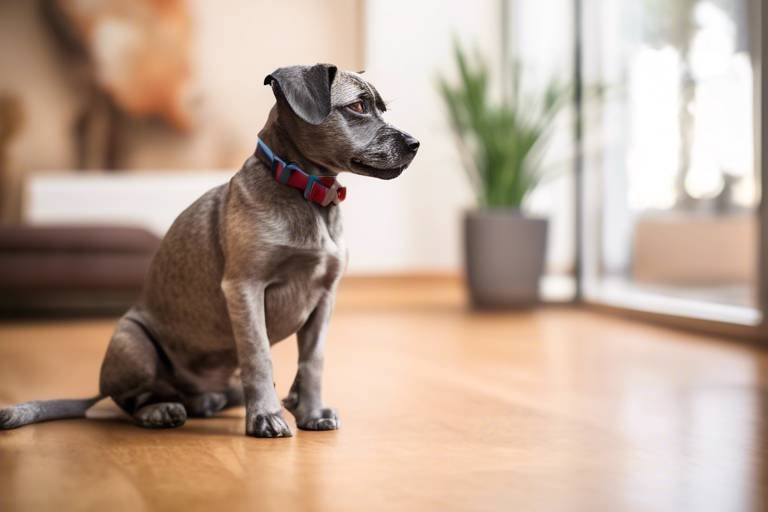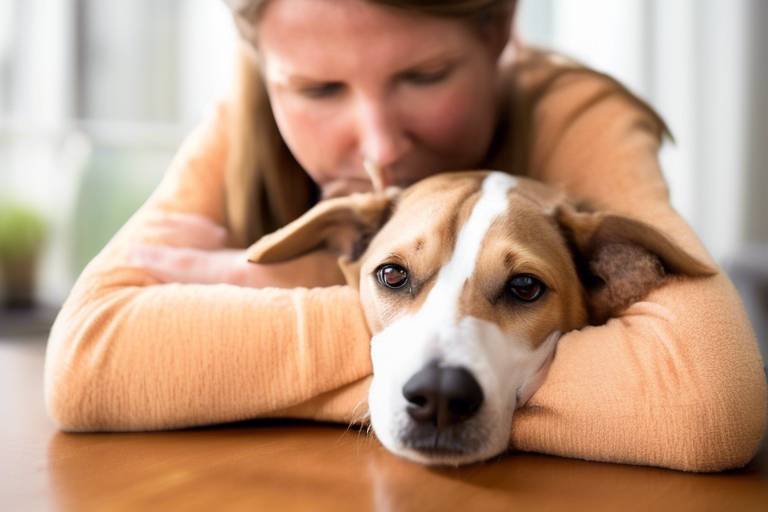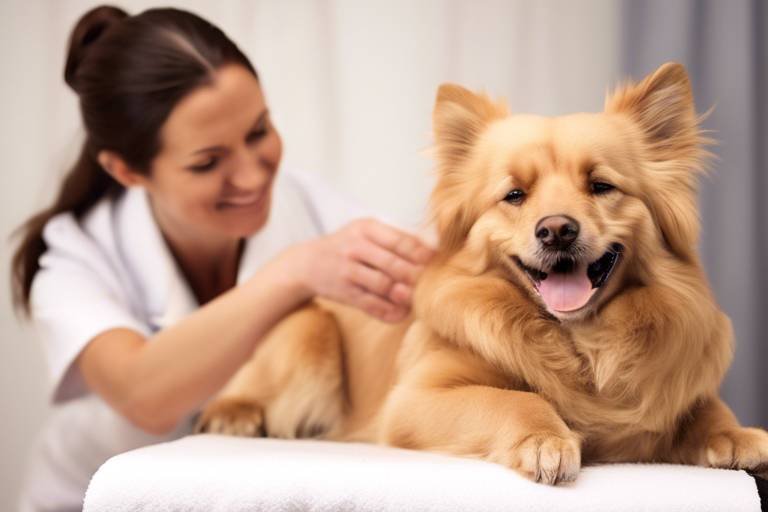Tips for Managing a Pet’s Transition to a New Home
Moving to a new home can be an exciting adventure, but for our furry friends, it can feel like the world is turning upside down. Just like us, pets experience a range of emotions when faced with significant changes in their environment. They may feel anxiety, confusion, or even fear. As a responsible pet owner, it's crucial to understand these feelings and take proactive steps to ease their transition. In this article, we will explore practical tips and strategies that can help your pet adjust to their new surroundings smoothly, ensuring they feel safe and loved throughout the process.
When you move, your pet is likely to experience a whirlwind of emotions. Imagine being uprooted from your cozy home and placed in a completely unfamiliar environment—sounds daunting, right? Pets can feel a mix of curiosity and stress, and recognizing these emotions is the first step in helping them adjust. Common feelings pets may experience include:
- Fear: New sounds, smells, and sights can be overwhelming.
- Confusion: They may not understand why their routine has changed.
- Separation Anxiety: Being away from familiar surroundings can lead to clinginess.
To address these emotions effectively, spend quality time with your pet, reassure them with gentle words, and maintain a calm demeanor. Remember, your energy influences theirs, so staying positive can help them feel more secure.
Creating a welcoming environment is essential for helping your pet settle into their new home. Start by setting up a designated area where your pet can feel safe and comfortable. This space should include their bed, food and water bowls, and some toys. Think of it as their little sanctuary amidst the chaos of moving. Here are a few steps to consider:
Selecting the ideal spot for your pet can significantly ease their transition. Consider factors such as:
- Quietness: A calm area away from the hustle and bustle of the household.
- Accessibility: Easy access to outdoor spaces for bathroom breaks.
- Comfort: A cozy spot with their favorite blanket or bed.
By choosing a space that feels secure, you help your pet create a sense of belonging in their new home.
During the initial adjustment period, it's vital to minimize noise and distractions. Loud sounds can heighten your pet's anxiety, so consider the following:
- Keep the television volume low.
- Avoid hosting large gatherings during the first few weeks.
- Use white noise machines or calming music to soothe your pet.
Creating a peaceful environment allows your pet to relax and explore their new space at their own pace.
Familiar items can be a great source of comfort for your pet. Bringing along their favorite toys, bedding, and even some of your clothes can help them feel more at home. These items carry the scent of their previous environment, creating a sense of familiarity that can ease anxiety. Think of it as a comforting hug from their old home, making the new place feel a bit less foreign.
Pets thrive on routine, and maintaining a consistent schedule during the transition can help them feel secure. Try to stick to regular feeding, walking, and playtime schedules. This predictability provides a sense of stability in an otherwise chaotic time. Just like a child benefits from a bedtime routine, your pet will appreciate the comfort of knowing what to expect each day.
Bringing new family members into the mix can be a bit tricky, especially for pets who are used to a certain dynamic. It's essential to facilitate positive interactions between your pet and any new companions. Here are some tips:
Supervised introductions are crucial for ensuring safety and comfort for everyone involved. Start by allowing your pet to observe new family members from a distance. Gradually decrease the space between them while monitoring their behavior closely. This way, you can intervene if necessary and help create a positive first impression.
Gradual integration can help ease tension between your pet and new household members. Consider the following techniques:
- Allow your pet to explore new areas of the home at their own pace.
- Encourage positive interactions through treats and praise.
- Provide separate spaces for your pet and new family members until they feel comfortable.
By fostering a harmonious environment, you can help build trust and ease any potential conflicts.
Keeping an eye on your pet's behavior during the transition is vital. Look out for signs of stress, such as excessive barking, hiding, or changes in appetite. If you notice any concerning behaviors, it’s essential to respond appropriately. Consider the following:
Identifying stress signals in pets can help you intervene early. Common behaviors that indicate your pet may be struggling with the transition include:
- Excessive grooming or licking.
- Destructive behavior.
- Changes in sleeping patterns.
By recognizing these signs, you can take steps to comfort your pet and provide the support they need.
Sometimes, professional assistance is necessary. If your pet shows prolonged signs of distress, consider consulting a veterinarian or a pet behaviorist. They can provide tailored advice and strategies to help your pet adjust more effectively. Remember, seeking help is a sign of a responsible pet owner who wants the best for their furry friend.
- How long does it take for a pet to adjust to a new home? - Every pet is different, but typically, it can take anywhere from a few days to several weeks for a pet to feel comfortable in their new environment.
- What should I do if my pet is not eating after the move? - If your pet refuses to eat, try offering their favorite treats or food. If the issue persists for more than a day, consult your veterinarian.
- Can I use calming products to help my pet adjust? - Yes, calming sprays, diffusers, and supplements can help ease anxiety in pets during the transition.

Understanding Your Pet’s Emotions
This article provides practical advice for pet owners on how to help their furry friends adjust to a new environment, ensuring a smooth and stress-free transition.
When you move to a new home, it's not just a change of scenery for you; your pet experiences a whirlwind of emotions too. Imagine how you'd feel if you were suddenly uprooted from your cozy space and dropped into a completely unfamiliar environment! Your furry friend may feel confused, anxious, or even scared during this transition. Recognizing these feelings is the first step in providing the support they need.
Pets, much like humans, can experience a range of emotions. They may feel fear as they encounter new sights, sounds, and smells, which can be overwhelming. Additionally, they may experience loss, particularly if they’ve left behind familiar surroundings or even friends (like other pets or neighbors). This emotional turmoil can manifest in various ways, such as hiding, excessive barking, or even destructive behavior. Understanding these signs is crucial in helping them adjust.
To effectively address your pet's emotional needs, you can take several steps. Start by observing their behavior closely. Are they seeking more affection, or are they retreating into their shell? These clues can help you tailor your approach. Here are some common emotions pets might experience during a move:
- Fear: New environments can be intimidating.
- Curiosity: They may want to explore but feel hesitant.
- Attachment: They might cling to you or their favorite items for comfort.
- Frustration: Changes in routine can lead to irritability.
By acknowledging and validating their feelings, you can create a supportive atmosphere. For example, spending extra time with your pet, engaging in their favorite activities, or simply offering a comforting presence can make a significant difference. Remember, patience is key. Just as you need time to adjust to a new place, so does your pet. They might need a few weeks to feel completely at home again.
In some cases, pets may exhibit unusual behavior due to stress. If you notice that your pet is excessively vocal, refuses to eat, or shows signs of aggression, it may be time to consult a professional. A veterinarian or a pet behaviorist can provide valuable insights and strategies tailored to your pet's specific needs. Ultimately, understanding your pet's emotions and responding appropriately can make the transition smoother for both of you.
Creating a welcoming space for your pet is crucial. Here, we outline steps to prepare your home, including setting up a designated area and ensuring a safe environment.
Selecting the ideal spot for your pet can ease their transition. This subheading covers factors to consider when choosing a space that feels secure and comfortable for your pet.
A quiet environment can help reduce anxiety in pets. This section discusses ways to minimize noise and distractions during the initial adjustment period.
Familiar items can provide comfort to your pet. Here, we explain the importance of bringing along their favorite toys, bedding, and other belongings to ease their anxiety.
A consistent routine can help pets feel secure in their new home. This subheading highlights the importance of maintaining feeding, walking, and play schedules during the transition.
Introducing pets to new family members can be tricky. This section offers tips on how to facilitate positive interactions and build trust between your pet and new companions.
Supervised introductions are essential to ensure safety. Here, we provide guidelines for managing initial meetings between your pet and new family members.
Gradual integration can help ease tension. This subheading discusses techniques to slowly introduce your pet to new household members, promoting a harmonious living environment.
Keeping an eye on your pet's behavior during the transition is vital. This section discusses signs of stress and how to respond appropriately to ensure their well-being.
Identifying stress signals in pets can help you intervene early. This subheading outlines common behaviors that indicate your pet may be struggling with the transition.
Sometimes, professional assistance is necessary. Here, we discuss when and how to seek help from veterinarians or pet behaviorists if your pet shows prolonged signs of distress.
1. How long does it take for a pet to adjust to a new home?
Most pets typically take a few weeks to adjust, but this can vary based on the individual pet's personality and past experiences.
2. What can I do if my pet seems overly anxious?
Try to create a safe space for your pet, maintain a routine, and consider consulting a veterinarian if anxiety persists.
3. Should I introduce my pet to new family members immediately?
It's best to introduce them gradually and under supervision to ensure a positive experience for both your pet and the new family members.

Preparing Your Home for Your Pet
Creating a welcoming space for your furry friend is not just a nice gesture; it’s a crucial step in ensuring that they feel comfortable and secure in their new environment. Think of it like preparing a cozy nest for a bird; you want to make it inviting and safe. Start by designating a specific area in your home where your pet can retreat to when they feel overwhelmed or need some alone time. This space should be away from the hustle and bustle of daily life, allowing them to relax and acclimate to their new surroundings without constant interruptions.
When setting up this area, consider your pet's needs. For instance, if you have a dog, a comfy bed, some toys, and access to water will create a nurturing environment. Cats, on the other hand, might appreciate a high perch or a cozy nook where they can observe their new territory from a safe distance. Remember, this designated space should be a haven, a place where they can feel at ease as they navigate the changes happening around them.
Another essential aspect of preparing your home is ensuring a safe environment. Just like child-proofing a house, pet-proofing is vital. Look around your home for potential hazards such as:
- Exposed electrical cords that could be chewed on.
- Houseplants that may be toxic to pets.
- Small objects that could be swallowed.
By taking these precautions, you can prevent accidents and create a safer space for your pet to explore. Additionally, consider using baby gates to restrict access to certain areas of the house until your pet is more comfortable and familiar with their new home.
Noise can also be a significant factor affecting your pet's comfort. Imagine being in a new place where the sounds are unfamiliar and potentially frightening. To help minimize anxiety, try to keep noise levels down, especially during the initial adjustment period. Close windows to block out outside sounds, and avoid loud activities like vacuuming or playing loud music. Instead, consider soothing background music or white noise to help mask any sudden sounds that could startle your pet.
Lastly, bringing along familiar items from your previous home can significantly ease your pet’s anxiety. Just like a child clinging to a favorite blanket, pets find comfort in their belongings. Make sure to pack their favorite toys, bedding, and any other items that smell like home. This familiarity can act as a bridge, helping them transition more smoothly into their new space. Remember, patience is key. Just like humans, pets need time to adjust, so create an environment that fosters love, security, and comfort.
Choosing the Right Space
When it comes to helping your pet adjust to a new home, one of the most critical elements is selecting the right space for them. Think of it as finding their own little sanctuary amidst the chaos of moving. Just like humans, pets thrive in environments where they feel safe and comfortable. So, how do you determine the perfect spot? Here are a few key factors to consider:
- Quietness: Look for a location that is away from the hustle and bustle of daily activities. A quieter area can significantly reduce your pet's anxiety levels.
- Accessibility: Ensure that the space is easily accessible for your pet. If your furry friend is older or has mobility issues, they should be able to reach their designated area without any difficulty.
- Natural Light: A well-lit area can uplift spirits. Pets, like humans, enjoy basking in the sun, so choosing a space with natural light can make it more inviting.
- Temperature Control: Make sure the area is not too hot or too cold. Pets can be sensitive to extreme temperatures, so maintaining a comfortable environment is essential.
Once you’ve identified a suitable space, it’s time to make it feel like home. Start by setting up a cozy bed or blanket that smells like them. This familiar scent can provide immense comfort during a time of change. You might also consider placing their favorite toys nearby, creating a welcoming atmosphere that encourages exploration and play.
Don’t forget to think about your pet's personality. For instance, if your pet is naturally shy, a secluded corner might be ideal. On the other hand, if they are social butterflies, a spot in the living room where they can interact with family members might be best. Remember, the goal is to create a space where your pet can retreat when they need a moment of peace, yet also feel included in family activities.
As you set up this new space, take your time. Allow your pet to explore it at their own pace. It’s crucial not to force them into any area they seem uncomfortable with. Just like a kid in a new school, they need time to adjust, understand their surroundings, and feel at ease. By being patient and observant, you’ll help your pet find their footing in this new chapter of their life.
In conclusion, choosing the right space for your pet is about more than just a physical location; it’s about creating an environment that fosters security, comfort, and a sense of belonging. With a little thought and effort, you can set the stage for a smooth transition, ensuring your furry friend feels right at home in no time.
Q: How long will it take for my pet to adjust to the new space?
A: The adjustment period varies for each pet. Some may adapt within a few days, while others could take weeks. Patience is key!
Q: Should I leave my pet alone in their new space?
A: Initially, it’s best to supervise your pet in their new area. Gradually increasing their alone time can help them feel more secure.
Q: What if my pet shows signs of stress in their new space?
A: If your pet seems anxious or stressed, try to create a more familiar environment with their favorite items. If stress persists, consult a veterinarian.
Minimizing Noise and Distractions
When you bring your pet into a new home, one of the most significant factors affecting their transition is the environment's noise level. Imagine how you would feel trying to settle into a new place while surrounded by loud sounds and constant distractions. For pets, this can be incredibly overwhelming and may lead to anxiety or stress. Therefore, it’s essential to create a calm and serene atmosphere to help your furry friend adjust.
Start by identifying potential sources of noise in your new home. This can include everything from the sound of traffic outside to the hum of appliances inside. Once you have pinpointed these distractions, you can take steps to minimize them. For instance, if there’s a busy street nearby, consider using heavy curtains to muffle the sounds or placing your pet’s bed in a quieter part of the house. Remember, your pet’s comfort is paramount, and they deserve a peaceful environment.
Another effective strategy is to establish a quiet zone within your home. This area should be designated for your pet to retreat to when they feel overwhelmed. Consider incorporating soft bedding, their favorite toys, and even a gentle, calming scent like lavender to create a soothing space. This sanctuary will serve as a safe haven where your pet can relax and feel secure, away from the hustle and bustle of daily life.
Moreover, it’s wise to limit loud activities during the initial days of your pet’s transition. If you have children, explain to them the importance of being gentle and quiet around the new pet. You might also want to avoid hosting large gatherings or playing loud music until your pet has settled in. Remember, patience is key; give your pet the time they need to adjust to their new surroundings.
Finally, consider using white noise machines or calming music designed specifically for pets. These can help drown out sudden noises that might startle your furry friend and create a more soothing atmosphere. You can find a variety of playlists online that cater to pets, which can be a delightful addition to your home environment.
By taking these steps to minimize noise and distractions, you’ll be paving the way for a smoother transition for your pet. Just think of it as creating a cozy nest for them to feel safe and secure in. After all, a happy pet means a happy home!
- How long does it take for a pet to adjust to a new home?
Every pet is different, but generally, it can take anywhere from a few days to several weeks for a pet to adjust to a new environment. - What should I do if my pet shows signs of stress?
Monitor their behavior closely and provide comfort through familiar items. If stress persists, consider consulting a veterinarian or a pet behaviorist. - Can I use calming products to help my pet adjust?
Yes, there are various calming products available, such as pheromone diffusers, calming collars, and supplements that can help reduce anxiety.
Providing Familiar Items
When it comes to helping your pet adjust to a new home, can play a crucial role in easing their anxiety. Just like us, pets find comfort in their belongings. Imagine moving to a new city without any of your favorite things; it can feel overwhelming and lonely, right? Similarly, your furry friend may feel lost in a new environment without their cherished items. Bringing along their favorite toys, blankets, and even the bed they’ve grown accustomed to can create a sense of familiarity that helps them settle in more easily.
Consider this: a pet’s sense of smell is incredibly powerful. When they encounter their own scent on familiar items, it can trigger feelings of safety and security. For instance, if your dog has a favorite squeaky toy, having it nearby can provide a comforting distraction during stressful moments. Moreover, their bedding, which carries their scent, can serve as a cozy retreat where they can curl up and feel at home. It's like having a piece of their old life in a new setting!
Here are some essential items to consider bringing along:
- Toys: Familiar toys can provide entertainment and comfort.
- Blankets: A favorite blanket can help them feel secure.
- Food and Water Bowls: Using their usual bowls can make mealtime feel more normal.
- Bed: Their bed can be a safe haven in a new environment.
Additionally, it’s important to maintain their usual routines as much as possible. If your pet has a specific toy they play with every day, make sure it’s accessible in their new home. This continuity can significantly reduce their stress levels and help them adapt more smoothly. Remember, the goal is to create a safe space where your pet can feel at ease and begin to explore their new surroundings at their own pace.
In summary, providing familiar items is not just about physical comfort; it’s about emotional reassurance. By surrounding your pet with their beloved belongings, you’re sending a clear message: “You’re safe here.” This simple act can make a world of difference in how quickly they adjust to their new home.
Q: How long does it usually take for a pet to adjust to a new home?
A: The adjustment period can vary significantly between pets. Some may adapt within a few days, while others might take weeks or even months. It's essential to be patient and supportive during this time.
Q: What should I do if my pet is still anxious after a few weeks?
A: If your pet shows prolonged signs of anxiety, consider consulting a veterinarian or a pet behaviorist. They can provide tailored advice and, if necessary, recommend behavioral therapies or medications.
Q: Can I introduce new toys to my pet during the transition?
A: Yes, introducing new toys can be beneficial, but it's best to do so gradually. Start with familiar items to create a safe environment, then slowly introduce new toys to keep things exciting.
Establishing a Routine
When it comes to helping your furry friend adjust to their new home, establishing a routine is one of the most effective strategies you can employ. Just like us, pets thrive on consistency and predictability. Imagine how chaotic it would feel if you suddenly had to change your daily schedule without any notice! Pets experience similar feelings when their environment shifts dramatically. By maintaining a regular routine, you not only provide a sense of security but also help them settle into their new surroundings more comfortably.
Start by keeping their feeding times consistent. If your dog or cat is used to being fed at 7 AM and 6 PM, stick to that schedule as closely as possible. This helps them understand that while their environment has changed, some things remain the same. Additionally, regular feeding times can prevent digestive issues that might arise from irregular eating habits.
Next, incorporate regular walks or play sessions into your daily agenda. For dogs, this means taking them out for walks at the same times each day. For cats, this could involve scheduled playtime with their favorite toys. Not only does this physical activity help burn off excess energy, but it also strengthens the bond between you and your pet, making them feel more at home. Think of it as a dance; when you both know the steps, the performance is much smoother!
Another essential aspect of establishing a routine is bathroom breaks. For dogs, it's crucial to maintain a consistent schedule for potty breaks, especially during the initial transition period. Cats, on the other hand, should have easy access to their litter box, and you should keep it in a familiar location. This predictability helps reduce accidents and keeps your pet feeling secure.
Lastly, don’t forget about bedtime! Pets, much like humans, benefit from a regular sleep schedule. Create a calming nighttime routine that signals to your pet that it’s time to wind down. This could involve quiet time, gentle petting, or even reading aloud to them. Over time, they’ll start to associate these activities with relaxation, making it easier for them to settle in for the night.
In summary, establishing a routine for your pet is about creating a sense of stability in an otherwise changing world. By sticking to consistent feeding, walking, play, and sleep schedules, you can help your pet navigate their new home with confidence and ease. Remember, patience is key during this transition, and the effort you invest in maintaining a routine will pay off in the long run.
- How long does it take for a pet to adjust to a new home?
Every pet is different, but typically it can take anywhere from a few days to several weeks for a pet to adjust to a new environment. Be patient and observant during this time. - What should I do if my pet shows signs of stress?
If you notice excessive barking, hiding, or changes in eating habits, it's important to reassure your pet. Spend extra time with them, and consider consulting a veterinarian if the behavior persists. - Can I change my pet’s routine after they’ve settled in?
Yes, once your pet has adjusted, you can gradually introduce changes to their routine. Just remember to do so slowly to avoid overwhelming them.

Introducing Your Pet to New Family Members
Bringing a new pet into your home can be an exciting yet challenging experience, especially when it comes to introducing them to new family members. Just like people, pets have their own personalities and quirks, and the dynamics of your household can change significantly with the addition of a furry friend. So, how can you ensure that this transition is smooth and harmonious? Let's dive into some practical tips and strategies to facilitate these introductions and foster a positive environment for everyone involved.
First and foremost, it’s essential to understand that patience is key. Pets can be sensitive to changes in their environment and may need time to adjust to new faces. A rushed introduction can lead to anxiety and stress for both your pet and your family members. Start by allowing your pet to explore their new surroundings without overwhelming them with too much interaction at once. This way, they can become familiar with the scents and sounds of their new home, making them feel more secure.
When it comes to introducing your pet to new family members, supervised introductions are crucial. This means that you should be present during the first few meetings to monitor how everyone interacts. For instance, if you have children, ensure they understand how to approach the pet gently and respectfully. You might want to explain to them the importance of reading the pet’s body language. Signs of comfort may include a wagging tail or relaxed ears, while signs of discomfort could manifest as growling, hiding, or raised fur. It’s a good idea to create a safe space where your pet can retreat if they feel overwhelmed.
Another effective strategy is to use gradual integration techniques. Start by allowing your pet to observe new family members from a distance. This could mean having family members sit quietly in the same room while your pet gets used to their presence. You can gradually decrease the distance over time as your pet becomes more comfortable. Offering treats or toys can also help create positive associations with new family members. For example, if a child is present, having them toss treats to the pet can help build trust and reduce any initial tension.
Moreover, it’s important to maintain a calm atmosphere during these introductions. If family members are excited or loud, it may heighten your pet’s anxiety. Consider using a soft tone of voice and gentle movements to create a more relaxed environment. You might even want to play some soft music in the background to help soothe your pet. Remember, the goal is to create a positive experience that encourages bonding between your pet and your family.
In some cases, you may need to set boundaries. If your pet shows signs of stress, it’s okay to give them a break and try again later. Consistency is vital, so make sure that everyone in the household is on the same page regarding how to interact with your new pet. Establishing rules, such as where the pet is allowed to go and how they should be treated, can help prevent misunderstandings and ensure a harmonious household.
Lastly, don’t forget to celebrate the small victories! Whether it’s a successful first meeting or your pet approaching a family member on their own, acknowledging these moments can help build confidence in your pet and strengthen the bond within your family. Remember, the journey may take time, but with love and patience, your new pet will soon feel like a cherished member of your family.
- How long does it take for a pet to adjust to new family members? - The adjustment period can vary based on the pet's personality and past experiences. Some pets may adapt quickly, while others might take weeks or even months.
- What should I do if my pet shows aggression towards new family members? - It’s important to remain calm and not punish your pet. Instead, give them space and consult a professional trainer or behaviorist for guidance.
- Can I introduce my pet to new family members all at once? - It’s best to introduce them gradually to avoid overwhelming your pet. Supervised interactions are key to ensuring safety and comfort.
Supervised Introductions
Introducing your pet to new family members can feel like a tightrope walk—one false step and it could lead to chaos! To ensure a smooth and positive experience, are crucial. This means that while your pet meets new humans or other animals in the household, you should be right there, keeping an eye on the interactions. Think of yourself as the referee in a friendly game; your role is to maintain peace and harmony.
Start the introductions in a controlled environment. Choose a quiet room where your pet feels comfortable, and make sure the new family member is calm and relaxed. You can even use a leash for your pet during the initial meeting, which allows you to control the situation if things get a little too excited. Remember, patience is key here! It’s essential to let both your pet and the new family member approach each other at their own pace. Rushing the process can lead to anxiety for both sides, which is the last thing you want.
During the introduction, watch for signs of stress or discomfort. If your pet starts to growl, hide, or show other signs of distress, it’s important to step in and give them a break. You might want to separate them for a while and try again later. On the flip side, if your pet shows curiosity or playful behavior, that's a good sign! It indicates they are open to making new friends. You could even reward positive interactions with treats or praise, reinforcing the idea that new family members are a good thing.
As the introductions progress, gradually increase the time they spend together. You can start with short sessions and then extend them as both your pet and the new family member become more comfortable. This gradual approach not only helps to build trust but also allows you to monitor their behavior closely. If you notice any signs of tension, don’t hesitate to intervene and redirect their focus. A toy or treat can work wonders to shift their attention and diffuse any potential conflict.
In summary, supervised introductions are a vital step in ensuring that your pet adjusts well to new family members. By keeping an eye on their interactions, you can foster a sense of security and comfort for everyone involved. Think of it as laying down the groundwork for a beautiful friendship—one that will blossom over time with a little love, patience, and understanding.
Gradual Integration Techniques
Integrating your pet into a new household can feel like a delicate dance, requiring patience and finesse. Just like humans, pets need time to adjust to new environments and companions, and a gradual approach can make all the difference. So, how do you go about this? First, it’s essential to set the stage for a successful introduction. Start by allowing your pet to explore their new surroundings without overwhelming them. This means giving them the space to sniff around, check out their new territory, and get comfortable without the pressure of meeting new family members all at once.
Once your pet has had some time to acclimate, you can begin the introduction process. One effective technique is to use scent swapping. This involves taking a blanket or toy that belongs to your new family member and letting your pet sniff it. Conversely, take something that belongs to your pet and let your new family member do the same. This helps to create a sense of familiarity and reduces the anxiety associated with meeting someone new.
When it’s time for the actual introduction, keep the initial meetings short and sweet. Imagine it like a first date; you wouldn’t want to overwhelm your partner with a marathon meeting, right? Start with brief interactions in a controlled environment. For example, you can have your new family member sit quietly in the same room while your pet explores. This allows your pet to observe from a safe distance, building their confidence.
As trust begins to build, you can gradually increase the time spent together. Always monitor their body language closely. Look for signs of stress or discomfort, such as growling, hissing, or excessive barking. If you notice any of these signals, it’s crucial to step back and allow your pet to retreat to a safe space. Remember, patience is key! It may take several sessions before your pet feels completely comfortable.
Another effective strategy is to incorporate positive reinforcement during these introductions. Reward your pet with treats or praise when they display calm behavior around the new family member. This not only reinforces good behavior but also creates positive associations with the new companion. You can use a simple table to track progress:
| Date | Duration of Interaction | Pet's Behavior | Reinforcement Used |
|---|---|---|---|
| Day 1 | 5 minutes | Curious | Treats |
| Day 2 | 10 minutes | Relaxed | Praise |
| Day 3 | 15 minutes | Playful | Treats + Play |
As time goes on, gradually increase the duration of these interactions, always ensuring that both your pet and the new family member feel comfortable and safe. It’s not just about the physical presence; emotional readiness is equally important. If your pet shows signs of distress, don’t hesitate to take a step back and reassess the situation. Sometimes, less is more.
In conclusion, the key to a successful gradual integration lies in taking your time, observing behaviors, and using positive reinforcement. By following these techniques, you can foster a peaceful and loving environment that allows your pet to thrive alongside new family members. Remember, every pet is unique, and what works for one may not work for another. Be flexible, stay patient, and watch your furry friend blossom in their new home!
- How long does it take for a pet to adjust to a new home? Each pet is different, but it can take anywhere from a few days to several weeks for a pet to fully adjust.
- What should I do if my pet shows aggression towards new family members? Always prioritize safety. Separate the pets and consult a veterinarian or a pet behaviorist for guidance.
- Can I introduce my pet to new family members all at once? It’s best to introduce them one at a time to avoid overwhelming your pet.

Monitoring Your Pet’s Behavior
When it comes to helping your furry friend adjust to a new home, one of the most crucial aspects is monitoring their behavior. Just like humans, pets can experience a whirlwind of emotions during transitions, and being attentive to their behavior can make all the difference. Have you ever noticed how a small change in your pet's demeanor can signal something deeper? Well, pets can’t verbally express their feelings, so it’s up to us to read the signs. Keeping a close eye on your pet can help you identify any signs of stress, discomfort, or anxiety that might arise as they settle into their new environment.
During this adjustment period, it's essential to look for specific behaviors that may indicate your pet is struggling. For instance, if your normally playful dog suddenly becomes withdrawn, or your cat hides more often than usual, these could be red flags. Here are some common signs of stress to watch out for:
- Excessive barking or meowing: This could indicate anxiety or frustration.
- Changes in appetite: Eating less or more than usual can be a sign of distress.
- Destructive behavior: Chewing furniture or scratching can be a way for pets to cope with stress.
- Hiding: If your pet seeks out secluded spots, they might be feeling overwhelmed.
By recognizing these behaviors early, you can intervene before they escalate into more significant issues. For example, if your pet is exhibiting signs of anxiety, try to create a calm and safe space for them. This could be a cozy corner with their favorite blanket or a quiet room away from the hustle and bustle of the household. Think of it as creating a little sanctuary where they can retreat to when things feel a bit too much.
Moreover, it’s essential to keep a consistent routine. Pets thrive on predictability, and maintaining their usual feeding, walking, and play schedules can help provide a sense of stability. If you notice your pet is still struggling despite your best efforts, it might be time to consider seeking professional help. Don’t hesitate to reach out to a veterinarian or a pet behaviorist. They can offer tailored advice and strategies to help your pet cope with the transition.
In conclusion, monitoring your pet's behavior during this period is not just about observing; it's about understanding and responding to their needs. By being proactive and attentive, you can ensure that your pet feels safe, secure, and loved in their new home.
Q: How long does it usually take for a pet to adjust to a new home?
A: The adjustment period can vary widely among pets. Some may settle in within a few days, while others might take weeks or even months. Patience and consistency are key.
Q: What should I do if my pet shows signs of severe anxiety?
A: If your pet displays extreme anxiety, it’s best to consult with a veterinarian or a pet behaviorist. They can provide guidance and may recommend behavior modification techniques or medications.
Q: Can I help my pet adjust by introducing them to new family members slowly?
A: Absolutely! Gradual introductions are often the best approach. Allow your pet to meet new family members in a controlled environment to build trust and reduce anxiety.
Q: Are there specific items I should bring to help my pet feel more at home?
A: Yes, bringing familiar items such as their favorite toys, bedding, and even some of your clothing can provide comfort and help them feel more secure in their new environment.
Recognizing Signs of Stress
When it comes to our pets, their happiness and well-being are often intertwined with how they adapt to changes in their environment. Recognizing the signs of stress in your furry friend is essential, especially during the transition to a new home. Just like humans, pets can experience a whirlwind of emotions, and sometimes, they express their discomfort in ways that might not be immediately obvious. So, how can you tell if your pet is feeling stressed?
First and foremost, observe their body language. Animals communicate a lot through their physical posture and movements. For instance, if your dog is tucking its tail between its legs, it could indicate fear or anxiety. Similarly, a cat that is hiding or avoiding interaction may be feeling overwhelmed. Here are some common signs that your pet may be under stress:
- Excessive barking or meowing: If your pet is suddenly more vocal than usual, it could be a cry for help.
- Changes in appetite: A sudden disinterest in food or overeating can signal distress.
- Destructive behavior: Chewing, scratching, or other destructive actions can often be a way for pets to cope with anxiety.
- Withdrawal: If your normally social pet is isolating itself, it could be a sign of stress.
- Over-grooming: Cats, in particular, may groom excessively as a way to self-soothe when they are anxious.
Understanding these signals can help you take immediate action to alleviate your pet's stress. For example, if you notice that your dog is barking incessantly, it might be time to reassess their environment. Are there loud noises or unfamiliar people that could be triggering this behavior? Creating a safe space for your pet where they can retreat when feeling overwhelmed is crucial.
Moreover, keeping a close eye on your pet's behavior during the first few weeks in a new home is essential. Changes in their usual routine can also lead to stress; for example, if they are used to being walked at a specific time and that schedule gets disrupted, they might feel unsettled. It’s important to maintain some semblance of normalcy amidst the chaos of moving. Establishing a routine can help your pet feel more secure.
In some cases, you might find that your pet's stress signals are persistent and not alleviated by your efforts. If this is the case, it’s crucial to consider seeking professional help. A veterinarian or a pet behaviorist can provide insights and strategies tailored to your pet’s specific needs. They can help you understand whether your pet's behavior is a temporary response to the new environment or something more serious that requires intervention.
In summary, being vigilant about your pet's behavior during this transitional period can make a world of difference. By recognizing the signs of stress early, you can take proactive steps to help your pet adjust, ensuring a smoother transition for both of you.
- How long does it take for a pet to adjust to a new home? - The adjustment period can vary widely among pets. Some may take only a few days, while others might need several weeks to feel comfortable.
- What should I do if my pet shows signs of stress? - Observe their behavior closely, maintain a routine, and create a safe space for them. If the stress persists, consider consulting a veterinarian.
- Are certain breeds more prone to stress during transitions? - Yes, some breeds are more sensitive than others. For instance, rescue dogs or those with a history of trauma may take longer to adjust.
- Can I help my pet feel more comfortable? - Absolutely! Providing familiar items, maintaining a routine, and offering plenty of love and attention can help ease their anxiety.
Seeking Professional Help
As much as we love our pets and want to provide them with the best care possible, there are times when things can get a bit overwhelming. If you notice that your furry friend is struggling to adjust to their new home, it might be time to consider seeking professional help. Just like humans, pets can experience anxiety and stress, and sometimes the support of a trained expert is necessary to help them through tough transitions.
So, when should you reach out for help? Here are some signs to look out for:
- Prolonged Anxiety: If your pet seems excessively anxious for weeks on end, it’s a good idea to consult a professional.
- Behavioral Changes: Noticeable changes in behavior, such as aggression, excessive barking, or withdrawal, can indicate deeper issues.
- Physical Symptoms: If your pet is showing signs of stress-related health problems, like loss of appetite or excessive grooming, it may be time to get help.
When you decide to seek professional assistance, you have a few options. You can start with a visit to your veterinarian, who can rule out any medical issues that could be contributing to your pet's behavior. They may also recommend a pet behaviorist or trainer specializing in anxiety and transition issues. Here’s a quick comparison of the two:
| Professional Type | Focus Area | Best For |
|---|---|---|
| Veterinarian | Medical issues and medication | Physical health concerns |
| Pet Behaviorist | Behavior modification techniques | Behavioral problems and training |
In many cases, a combination of veterinary care and behavioral training can yield the best results. It's essential to communicate openly with the professionals about your pet's specific issues and to follow their recommendations closely. Remember, you're not alone in this journey, and seeking help is a sign of being a responsible pet owner.
Lastly, don’t forget to be patient with your pet during this process. Just like humans, pets need time to adjust and heal. With the right support and a little love, your furry friend will be on their way to feeling comfortable and happy in their new home.
- How do I know if my pet needs professional help? Look for signs of prolonged anxiety, behavioral changes, or physical symptoms like loss of appetite.
- What should I expect during a consultation with a veterinarian or behaviorist? Expect a thorough examination of your pet’s behavior and health, along with personalized recommendations.
- Can I help my pet adjust without professional help? Yes, but if you notice persistent issues, seeking professional guidance is advisable.
Frequently Asked Questions
- How can I tell if my pet is stressed during the move?
Pets may show signs of stress through changes in behavior. Look for signs like excessive barking, hiding, or changes in eating habits. If your pet seems unusually clingy or withdrawn, it might be feeling anxious about the new environment.
- What are some effective ways to create a welcoming space for my pet?
Start by setting up a specific area in your new home just for your pet. Include their bed, toys, and familiar items to help them feel secure. Make sure this space is quiet and away from the hustle and bustle of moving activities.
- How long does it usually take for a pet to adjust to a new home?
The adjustment period can vary depending on the pet's personality and previous experiences. Some pets may adapt within a few days, while others might take several weeks. Patience and consistency are key to helping them feel at home.
- Should I introduce my pet to new family members right away?
It's best to take it slow. Start with supervised introductions in a controlled environment. Allow your pet to approach new family members at their own pace, and always monitor interactions to ensure everyone feels safe and comfortable.
- What should I do if my pet continues to show signs of distress after moving?
If your pet shows prolonged signs of distress, consider consulting a veterinarian or a pet behaviorist. They can provide tailored advice and may suggest strategies or treatments to help your pet cope with the transition.
- How can I help my pet maintain a routine after the move?
Try to stick to your pet's usual schedule as closely as possible. Keep feeding, walking, and playtimes consistent. This familiarity can provide a sense of security and help your pet adjust more smoothly to the new surroundings.



















